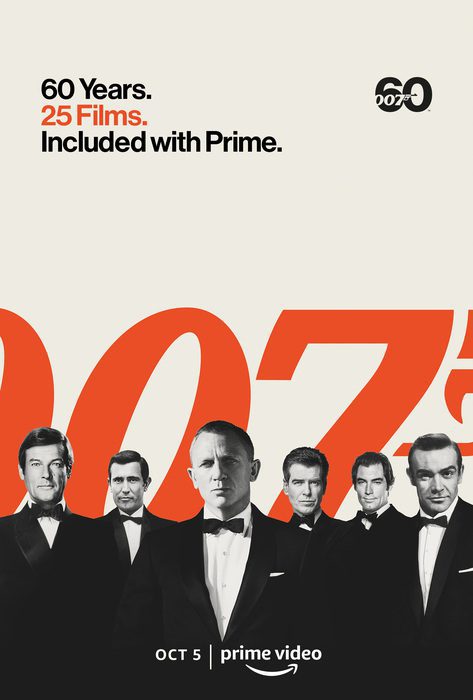James Bond is 60, and fans of Britain’s most famous superspy cultural export can celebrate with a new documentary exploring the series’ music over 25 films and a range of artists and composers, from Dr. No to No Time to Die. Over that time, the series has produced what is perhaps cinema’s most recognizable theme and a range of signature songs, from utter dreck to fabulous schlock, rock pyrotechnics to impassioned soul, with New Wave, alt-pop, and techno in between. The Sound of 007, streaming on Amazon Prime Video, explores the making and meaning of Bond films’ music.
Everyone, of course, knows the signature dum di-di dum dum di-dum di-di- dum dum low-note electric guitar riff leading off what’s known as the “James Bond theme.” According to Monty Norman, the riff was inspired by an Indian-flavored song he’d composed for a play set in Trinidad; John Barry then was asked, according to producers, to flesh out the riff with orchestration for Dr. No, and the resultant theme has been used to begin nearly every Eon Studios Bond film. A happy accident, perhaps, but the film elides any mention of the litigation between Norman and Barry: the two enjoined years of lawsuits and bickering over ownership of the film’s composition before The Sunday Times paid out a libel settlement to Norman, settling the matter.
One thing is for sure: that that famous riff and the theme song it introduced made James Bond films a highly stylized, immediately recognizable product. The song was a product of its time, the swingin’ Sixties of tony London, and a proud cultural export that glossed up a rock-and-roll riff in a slickly Brylcreemed coif to sell to the world. (It had only a little in common with, say, the guitar-handclap-and-whistle frugality of Ennio Morricone’s theme for a Fistful of Dollars.) The film’s decision—to ignore the gritty legal details in favor of a high-gloss lovefest—says much about The Sound of 007′s approach to its topic. This is a documentary offered up in service to the franchise, dedicated to touting its virtues and ignoring its controversies.
The signature theme is the most consistent and recognizable element of Bond-movie music. Less consistent—in fact, wildly inconsistent, yet sometimes every bit as recognizable—are its individual songs. Neither Dr. No nor From Russia with Love employed one, but ever since 1964’s Goldfinger the series’ featured songs have been as consistent a staple as its theme. There have been great ones, to be sure, beginning with Shirley Bassey’s glorious performance of “Goldfinger,” which somehow wedded awkward rhymes (“cold finger”) to the notes of “Moon River” and yet she still sold with a bravura performance that earned her callbacks for Diamonds Are Forever and Moonraker. Nancy Sinatra nailed You Only Live Twice and Adele Skyfall. Carly Simon’s lusty “Nobody Does It Better” (from The Spy Who Loved Me) has its fans; Paul McCartney’s pyrotechnic “Live and Let Die” couldn’t save the Roger-Moore starring blaxploitation ripoff by the same name, but it’s closed out his live concerts for nearly a half-century. Brawny Tom Jones practically wrestled Thunderball to the mat.
Others didn’t fare as well. Rita Coolidge tamed the sexy spy with the Muzak-inspired sopfest “All Time High.” A-ha, Chris Cornell, Madonna, and Sheryl Crow all shot their shots without hitting the target. Jack White gets a fair amount of screentime here, talking about his Quantum of Solace (quick, what rhymes with quantum? or for that matter, solace? No wonder they went with the pedestrian “Another Way to Die”) collaboration with Alicia Keys—and the weird-ass guitar solo that seemed to confound not only audiences and the producers but even his collaborator. Billie Eilish and Finneas, who composed the moving “No Time to Die” for the franchise’s most recent entry, are featured at length, discussing their contribution to the film as well as others.
DIrector Mat Whitecross devotes a considerable amount of time to No Time to Die, exploring how the film integrates both theme and song for its moving final sequence. If you’ve yet to see that most recent entry in Eon’s Bond canon, don’t watch The Sound of 007 hoping to remain unspoiled. Yet an explication of how the film delays the use of its signature theme until its most climactic moment, teasing its viewers with unexplored opportunities to do so earlier, is hardly as interesting or impactful as experiencing the film itself—and I say this as an academic who’s spent a considerable amount of time engaged in exactly that kind of explication.
Aside from No Time to Die, nearly every other Bond film gets short shrift, comparatively. In an effort to keep a sprightly—at times, panting—pace, Whitecross and his team employ every contemporary documentary gimmick available, from split screens and animations to reenactments and montage sequences, all conspiring to keep the program moving while talking heads tell us what we need to know. For a documentary ostensibly dedicated to music, The Sound of 007 won’t let you enjoy a single piece from start to finish: there’s a few bars of Bassey here, some Duran Duran snippets there, and some blissfully vintage footage of an aged Louis Armstrong performing “We Have All the Time in World” (a secondary theme in the too-often underrated On Her Majesty’s Secret Service but resuscitated for No Time to Die).
There are also a few charming anecdotes along the way. I think we all knew the lyrics to “The Man with the Golden Gun” (Lulu’s execrable 1974 effort) were delivered with a nod and a wink as an elegy to the spy’s manhood: “He has a powerful weapon / he charges a million a shot … who will he bang? / we shall see.” But take a close look too at the lyrics of “Diamonds Are Forever”: “Hold one up and then caress it / Touch it, stroke it and undress it.” It may take a Shirley Bassey to sell it, but that’s one phallic cigar there. Tina Turner, meanwhile, throws U2 lead singer Bono under the bus for his craptastic demo of “Goldeneye,” a song she nearly saved. There’s some excellent behind-the-scenes content featuring recent composers Hans Zimmer and David Arnold in particular.
Curiously, especially since the film never allows a full performance of any Bond song, The Sound of 007 devotes one section to those artists who never performed one. Think about that for a second: there’s probably a reason why there’s no Wikipedia page devoted to the topic. Granted, the late Amy Winehouse’s planned contribution deserves a moment of lament (and might help explain why the White-Keys collaboration was a rushed replacement). But all in all, it’s a curious choice for a documentary devoted to Bond music to spend much time on what never got recorded.

You might be inspired, though, after watching The Sound of 007, to treat yourself to a Spotify playlist of official Bond songs, perhaps topped off with a few non-canon entries (I always dug Moby’s frenetic riff on the theme). Or if you subscribe to Amazon Prime Video, where this documentary streams, a long traipse through all the Eon Bond films streaming there, from Sean Connery and George Lazenby right through Roger Moore, Timothy Dalton, Pierce Brosnan, and the now-retired Daniel Craig: check out our own 60th-anniversary rankings, courtesy of Will Scheiber.
The Sound of 007 likely won’t provide much new for serious cinephiles or film-music buffs (the kind who’ve read, for instance, John Burlingame’s The Music of James Bond. But for those looking to spend an innocuous, sprightly-paced, and slightly superficial 88 minutes enjoying a handful of highlights and tidbits celebrating its sexagenarian subject, this documentary is just the place to engage the music of Bond—James Bond.



